These refugee and immigrant narratives teach readers about language, culture, history, geography, and politics while providing insight into the human experience. The books reviewed in this column follow the journeys of young people and their families as they leave different parts of the world in pursuit of happiness and security.
Ages 4–8
Lost and Found Cat: The True Story of Kunkush’s Incredible Journey. Doug Kuntz & Amy Shrodes. Ill. Sue Cornelison. 2017. Crown/Random House.
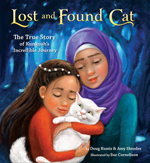 When their lives are endangered by war, Sura and her family are smuggled out of their home in Mosul, Iraq, taking only what they can carry and their white cat, Kunkush. Their escape takes them across mountains to a Kurdish village, and then to Istanbul, where they eventually board a small open boat to a Greek island in the Aegean Sea. Once on shore, Kunkush, wet and frightened by the crossing, escapes from his carrier. Near death from starvation, he is rescued by a volunteer who begins a search to reunite the cat with its family. Illustrated in rich, warm hues, the book includes photographs of Kunkush, his family, and people who cared for him.
When their lives are endangered by war, Sura and her family are smuggled out of their home in Mosul, Iraq, taking only what they can carry and their white cat, Kunkush. Their escape takes them across mountains to a Kurdish village, and then to Istanbul, where they eventually board a small open boat to a Greek island in the Aegean Sea. Once on shore, Kunkush, wet and frightened by the crossing, escapes from his carrier. Near death from starvation, he is rescued by a volunteer who begins a search to reunite the cat with its family. Illustrated in rich, warm hues, the book includes photographs of Kunkush, his family, and people who cared for him.
My Beautiful Birds. Suzanne Del Rizzo. 2017. Pajama Press.
 Set against the backdrop of the Syrian civil war, Sami finds solace in his connection with birds. When he and his family flee their hometown and find shelter in a refugee camp, Sami is devastated to leave his pet pigeons behind. His father tries to console him by reminding him that the birds likely escaped too, but Sami still can’t stop thinking about them. When pigeons appear in the camp, he feeds them seeds and spilled lentils, beginning his long healing process. Illustrations in polymer clay and acrylic paint show Sami’s slow transition into in his new life. The author’s note provides context about the Syrian war and information about the refugee camps.
Set against the backdrop of the Syrian civil war, Sami finds solace in his connection with birds. When he and his family flee their hometown and find shelter in a refugee camp, Sami is devastated to leave his pet pigeons behind. His father tries to console him by reminding him that the birds likely escaped too, but Sami still can’t stop thinking about them. When pigeons appear in the camp, he feeds them seeds and spilled lentils, beginning his long healing process. Illustrations in polymer clay and acrylic paint show Sami’s slow transition into in his new life. The author’s note provides context about the Syrian war and information about the refugee camps.
The Treasure Box. Margaret Wild. Ill. Freya Blackwood. 2017. Candlewick.
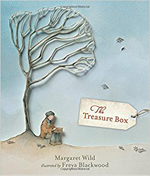 When the enemy bombs the village’s library, only one book survives. In this parable of war, Peter and his father are forced to flee their home. Peter’s father insists on taking the book, which he says is “about our people.” They wrap the book in cloth and keep it in a metal box in their suitcase. When his father dies of illness, Peter buries the metal box under a linden tree. The expressive illustrations, rendered in pencil, watercolor, and collage, depict Peter’s return to his native land to place the hidden book on the shelves of the rebuilt library “where, once again, it could be found, and read . . . and loved.”
When the enemy bombs the village’s library, only one book survives. In this parable of war, Peter and his father are forced to flee their home. Peter’s father insists on taking the book, which he says is “about our people.” They wrap the book in cloth and keep it in a metal box in their suitcase. When his father dies of illness, Peter buries the metal box under a linden tree. The expressive illustrations, rendered in pencil, watercolor, and collage, depict Peter’s return to his native land to place the hidden book on the shelves of the rebuilt library “where, once again, it could be found, and read . . . and loved.”
Ages 9–11
Greetings, Leroy. Itah Sadu. Ill. Alix Delinois. 2017. Groundwood/House of Anansi.
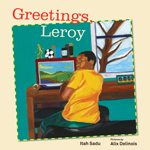 Roy misses his home in Jamaica. He’s nervous to start his first day of school in a new country and nothing—not even Bob Marley songs—can calm him down. When he sees a photo of Bob Marley playing soccer in the principal’s office, Roy begins to relax. The rich acrylic and mixed media illustrations depict Roy’s journey to feel accepted and valued in his new home.
Roy misses his home in Jamaica. He’s nervous to start his first day of school in a new country and nothing—not even Bob Marley songs—can calm him down. When he sees a photo of Bob Marley playing soccer in the principal’s office, Roy begins to relax. The rich acrylic and mixed media illustrations depict Roy’s journey to feel accepted and valued in his new home.
One Good Thing About America. Ruth Freeman. Ill. Katherin Honesta. 2017. Holiday House.
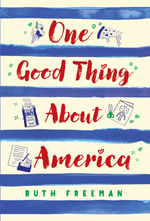 Anaïs, her mother, and her little brother Jean-Claude have arrived in America after fleeing the Congo. In a series of letters to her grandmother, Anaïs recounts her life in school and in the shelter. American language and habits confuse and discourage Anaïs, but she finds solace in having the best handwriting in class and in her knowledge of mathematics—since numbers are always the same. Her mother seeks asylum so that Anaïs’s father (an activist in their homeland) and older brother can come to America. Throughout the year, Anaïs reports good things she discovers about America to her grandmother, and she learns that her father and brother are safe in a refugee camp in Africa. In an author’s note, Freeman explains what inspired her to become an ELL teacher, and says that she wanted this novel to offer a glimpse into the life of a student new to America.
Anaïs, her mother, and her little brother Jean-Claude have arrived in America after fleeing the Congo. In a series of letters to her grandmother, Anaïs recounts her life in school and in the shelter. American language and habits confuse and discourage Anaïs, but she finds solace in having the best handwriting in class and in her knowledge of mathematics—since numbers are always the same. Her mother seeks asylum so that Anaïs’s father (an activist in their homeland) and older brother can come to America. Throughout the year, Anaïs reports good things she discovers about America to her grandmother, and she learns that her father and brother are safe in a refugee camp in Africa. In an author’s note, Freeman explains what inspired her to become an ELL teacher, and says that she wanted this novel to offer a glimpse into the life of a student new to America.
Stormy Seas: Stories of Young Boat Refugees. Mary Beth Leatherdale. Ill. Eleanor Shakespeare. 2017. Annick.
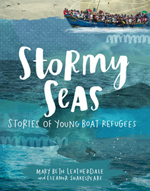 Stormy Seas follows the journeys of five teenage refugees escaping war, persecution, and possible murder in search of asylum. Ruth and her family board the St. Louis to escape nazism; Phu departs from war-torn Vietnam; José ventures to the U.S. from Cuba; Najeeba flees Afghanistan; and Mohamed, an orphan, runs from his village on the Ivory Coast. After traveling thousands of miles to reach safety, however, they find they are treated as outsiders and sometimes prisoners. Their stories recount experiences of loss, risk, betrayal, fortitude, and patience. The book includes a timeline and further information about refugee movements in the 20th-century
Stormy Seas follows the journeys of five teenage refugees escaping war, persecution, and possible murder in search of asylum. Ruth and her family board the St. Louis to escape nazism; Phu departs from war-torn Vietnam; José ventures to the U.S. from Cuba; Najeeba flees Afghanistan; and Mohamed, an orphan, runs from his village on the Ivory Coast. After traveling thousands of miles to reach safety, however, they find they are treated as outsiders and sometimes prisoners. Their stories recount experiences of loss, risk, betrayal, fortitude, and patience. The book includes a timeline and further information about refugee movements in the 20th-century
Ages 12–14
A Crack in the Sea. H. M. Bouwman. 2017. Putnam/Penguin.
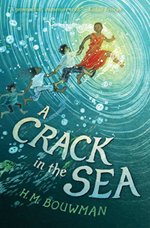 In a visit to the islands of Putnam, the Raft King of the Second World kidnaps Pip, who has the power to talk to fish. Putnam wants Pip to use his power to get the fish to lead them to the portal to the First World so that he can find his mother, who abandoned him. Woven into the fantasy are flashbacks from the history of the First World, including the forced migration of slaves from Africa to Jamaica, and refugees escaping post-war Vietnam by sea. When a storm rises, the portal opens and figures from the First World are swept into the Second World where they meet Kinchen, Pip, and Putnam. In an afterword Bouwman explains the inspiration for the fantasy and his writing process.
In a visit to the islands of Putnam, the Raft King of the Second World kidnaps Pip, who has the power to talk to fish. Putnam wants Pip to use his power to get the fish to lead them to the portal to the First World so that he can find his mother, who abandoned him. Woven into the fantasy are flashbacks from the history of the First World, including the forced migration of slaves from Africa to Jamaica, and refugees escaping post-war Vietnam by sea. When a storm rises, the portal opens and figures from the First World are swept into the Second World where they meet Kinchen, Pip, and Putnam. In an afterword Bouwman explains the inspiration for the fantasy and his writing process.
Hidden. Miriam Halahmy. 2016. Holiday House.
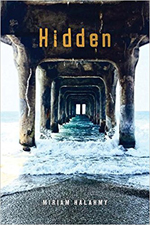 Fourteen-year-old Alix lives on an island off the coast in England with her mother. When Samir (a new student at school) is ruthlessly bullied, Alix decides to befriend him. She learns that Samir, his brother, and his aunt are all refugees from Iraq, seeking asylum. During a stormy afternoon, she and Samir save a badly beaten young man, Mohammed, from drowning in the surf. They hide him in an abandoned hut in a wooded area and nurse him back to health. They learn that Mohammed is also an Iraqi refugee. Desperate not to be deported, Alix must keep Mohammed's secret.
Fourteen-year-old Alix lives on an island off the coast in England with her mother. When Samir (a new student at school) is ruthlessly bullied, Alix decides to befriend him. She learns that Samir, his brother, and his aunt are all refugees from Iraq, seeking asylum. During a stormy afternoon, she and Samir save a badly beaten young man, Mohammed, from drowning in the surf. They hide him in an abandoned hut in a wooded area and nurse him back to health. They learn that Mohammed is also an Iraqi refugee. Desperate not to be deported, Alix must keep Mohammed's secret.
Ages 15+
The Best We Could Do: An Illustrated Memoir. Thi Bui. 2017. Abrams.
 This graphic novel is both a memoir and a history of 20th-century Vietnam. Bui chronicles generations of her family’s history, alternating between her father’s and her mother’s perspective. Her father grew up in northern Vietnam and lost his mother at the end of World War II. Bui’s mother was educated, French-speaking and lived in southern Vietnam.Through their stories, Bui illustrates her family’s resourcefulness as they flee Vietnam to start a new life in America.
This graphic novel is both a memoir and a history of 20th-century Vietnam. Bui chronicles generations of her family’s history, alternating between her father’s and her mother’s perspective. Her father grew up in northern Vietnam and lost his mother at the end of World War II. Bui’s mother was educated, French-speaking and lived in southern Vietnam.Through their stories, Bui illustrates her family’s resourcefulness as they flee Vietnam to start a new life in America.
The Lines We Cross. Randa Abdel-Fattah. 2017. Scholastic.
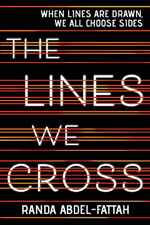 Mina has lived with her mother in Sydney for 10 years since fleeing Afghanistan after the death of her father and aunt. Now her mother and stepfather have moved the family to a different part of the city where they open an Afghani restaurant. She finds herself on one side of a rising anti-refugee, anti-immigrant movement organized by the father of Michael, a fellow student at her prestigious high school. The story of school, family, politics, and their relationship unfolds, told from Mina’s and Michael’s points of view. Michael finds himself questioning his parents’ views towards refugees and immigrants finding them less and less reasonable and credible, and Mina shares the reality of her life while she works to contribute to her family and her adopted country.
Mina has lived with her mother in Sydney for 10 years since fleeing Afghanistan after the death of her father and aunt. Now her mother and stepfather have moved the family to a different part of the city where they open an Afghani restaurant. She finds herself on one side of a rising anti-refugee, anti-immigrant movement organized by the father of Michael, a fellow student at her prestigious high school. The story of school, family, politics, and their relationship unfolds, told from Mina’s and Michael’s points of view. Michael finds himself questioning his parents’ views towards refugees and immigrants finding them less and less reasonable and credible, and Mina shares the reality of her life while she works to contribute to her family and her adopted country.
Sandip LeeAnne Wilson serves as professor in the English department and School of Education at Husson University, Bangor, Maine.
These reviews are submitted by members of the International Literacy Association's Children's Literature and Reading Special Interest Group (CL/R SIG) and are published weekly on Literacy Daily.